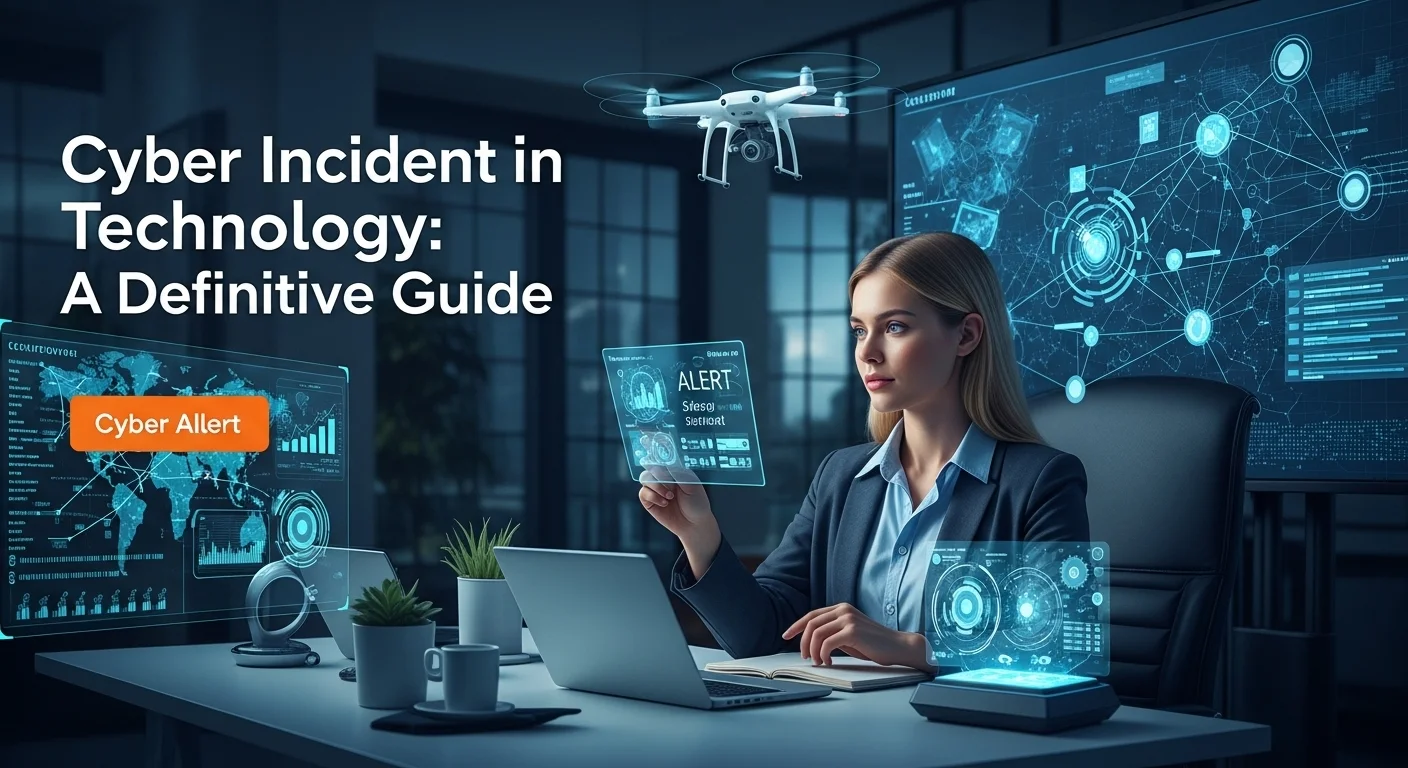Surviving a Cyber Incident: An Insider's Guide for Your Business

Executive Summary
Let's be honest: in today's world, it's not *if* your business will face a cyber incident, but *when*. I've been on the front lines of these digital crises for years, and I've seen firsthand how a single event can devastate a company. But I've also seen how the right preparation can turn a potential catastrophe into a manageable problem. This guide isn't filled with confusing jargon. It's my straightforward advice on what a cyber incident truly is, why you need a plan, and how to build one that actually works. We'll cover the essential steps for responding to an attack, the value of having experts on your side, and how to use frameworks like NIST as your roadmap to a safer, more resilient business.
Table of Contents
- What is a Cyber Incident, Really? (Beyond the Jargon)
- Why This Isn't Just an 'IT Problem'
- The Real-World Consequences of an Attack
- The Blueprint for a Strong Defense: The NIST Framework
What is a Cyber Incident, Really? (Beyond the Jargon)
In my line of work, I hear a lot of terms thrown around: 'security event,' 'data breach,' 'cyber incident.' They might sound the same, but the difference is critical. Think of it this way: a 'security event' is like someone jiggling the doorknob of your office. It happens all the time, and most are harmless. A 'data breach' is when they get in and steal specific, sensitive files. But a 'cyber incident' is the confirmed break-in itself—the moment you know a malicious actor has compromised your digital space. It’s an event that threatens the confidentiality (keeping secrets safe), integrity (keeping data accurate), or availability (keeping systems running) of your business technology.
The reason this distinction matters is that a confirmed incident requires an immediate, structured response. It's the official starting bell for your defense plan. In today's hyper-connected world, where everything from your accounting software to your customer relationships lives online, your 'attack surface'—all the possible entry points for a hacker—is huge. Remote work, cloud services, and even smart devices in the office have torn down the old fortress walls. This is why having a clear understanding and a plan for a cyber incident isn't just a good idea; it's a fundamental part of modern business survival.
Why This Isn't Just an 'IT Problem'
One of the biggest mistakes I see leaders make is thinking a cyber incident is a problem for the IT department to solve alone. It's not. This is a business problem, through and through. When an incident occurs, it doesn't just impact servers and software; it impacts your entire operation. Your ability to make products, serve customers, and manage your finances can grind to a halt. Effective cyber incident management is the process that coordinates the entire business—from the CEO to the legal team to communications—to navigate the crisis. It’s about making sure the response is orderly and decisive, not chaotic and panicked. At the heart of this is incident handling, which are the specific, hands-on technical steps your team takes to fight the fire. A solid plan ensures that everyone knows their role when the alarm bells start ringing.
The Real-World Consequences of an Attack
So, what's really at stake? The consequences are far more than a technical headache. First, there's the financial hit. I've seen companies face staggering costs from regulatory fines (like GDPR), legal fees, and the sheer expense of hiring experts to clean up the mess. That's before you even count the lost revenue from being offline for days or weeks. Then there's the damage to your reputation. Customer trust is incredibly hard to earn and shockingly easy to lose. A public incident can tarnish your brand for years, impacting sales and even your stock price. Finally, the operational disruption can be crippling. Imagine being unable to access your customer data, process orders, or run your production line. A major incident can bring a business to its knees. This is why a proactive defense is the best investment you can make.
The Blueprint for a Strong Defense: The NIST Framework
When clients ask me where to start, I always point them to the same place: the NIST cyber incident response framework. Developed by the U.S. National Institute of Standards and Technology, it's the gold standard for a reason. It's not a rigid set of rules, but a flexible, common-sense lifecycle that any organization can adapt. It breaks down the entire process into four logical phases: Preparation; Detection & Analysis; Containment, Eradication, & Recovery; and Post-Incident Activity. We’ll dive into what these mean for you in the next section. The beauty of this framework is that it emphasizes continuous learning. It turns a crisis into an opportunity to get stronger, which is the very definition of resilience. Many businesses find that navigating this requires specialized knowledge, which is where cyber incident response companies come in. These expert firms provide the skills and tools to manage an incident effectively, turning a complex framework into a real-world, actionable plan.

A Complete Guide to Responding: The Four Phases in Action
The NIST framework isn't just theory; it's a practical roadmap for what to do before, during, and after a cyber incident. I've guided countless organizations through this lifecycle, and I can tell you that mastering these phases is the key to minimizing damage and recovering quickly.
Phase 1: Preparation – Your Pre-Flight Checklist
This is, without a doubt, the most important phase. Everything you do here determines how smoothly things will go when a real incident strikes. This is your chance to get your house in order. It starts with creating a formal Incident Response Plan (IRP). This document should clearly define who is on your response team, what their roles are, and who has the authority to make critical decisions, like taking a system offline. It also means getting the right tools in place, like security software that can monitor your network and devices for suspicious activity. But most importantly, it involves training your people. Run drills and simulations so your team can practice the plan. Preparation is proactive, and it's the best defense you have.
Phase 2: Detection & Analysis – The Digital Detective Work
This phase begins when a potential incident is spotted. The trigger could be an automated alert from your security software, an employee reporting something strange, or even a tip from an outside party like the FBI. Once the alarm is raised, the clock starts ticking. Your team's job is to quickly figure out what's going on. Is this a real attack or a false alarm? If it's real, what kind of attack is it? Who is affected? What have they accessed? This is meticulous work that requires skill and the right tools to piece together the clues. Documenting every finding is crucial, as it will guide your entire response.
Phase 3: Containment, Eradication, & Recovery – Stop the Bleeding, Fix the Wound
Once you understand the problem, it's time to act. The first priority is containment—stopping the attack from spreading and causing more damage. This could mean isolating an infected laptop from the network or blocking a malicious IP address. Next comes eradication, which is about completely removing the threat from your environment. This might involve deleting malware, patching the vulnerability the attacker used, and resetting all compromised passwords. Finally, the recovery phase focuses on getting back to business. This means carefully restoring systems from clean backups and monitoring them closely to ensure the threat is truly gone. This must be done methodically, not rushed.
Phase 4: Post-Incident Activity – Learn and Improve
After the dust has settled, the work isn't over. This 'Lessons Learned' phase is what separates resilient organizations from those that get hit again and again. Get everyone involved in the response into a room and have an honest conversation. What did we do well? Where did we fail? Did our plan work as expected? The goal is to identify weaknesses and create a concrete plan to fix them. This feedback loop is what makes the NIST framework so powerful. It ensures that every incident, no matter how painful, makes you a stronger, smarter, and more secure organization. For many, bringing in outside help from cyber incident response companies during this phase provides an objective, expert view that is hard to achieve internally. They've seen hundreds of incidents and can provide insights you'd never get on your own.

Tips and Strategies to Build Your Digital Resilience
Moving from theory to practice is what truly protects your business. Improving your technology experience isn't about buying every flashy new tool; it's about building a smart, proactive, and resilient security culture. Here are the strategies I share with all my clients.
Tip 1: Make Your Plan a Living Document
An Incident Response Plan (IRP) that just sits on a shelf is worthless. You have to bring it to life. The best way to do this is through 'tabletop exercises.' These are simulated crises where you gather your response team—including leaders from legal, HR, and communications—and walk through a scenario. It's a dress rehearsal that builds muscle memory and reveals gaps in your plan before a real crisis hits. Update your plan based on what you learn. Do this at least once a year.
Tip 2: Your People Are Your Best Defense
Technology can't catch everything. Your employees are your human firewall, but they need training. Go beyond the once-a-year compliance video. Run regular phishing simulations to teach them how to spot malicious emails in a safe environment. Teach them good cyber hygiene, like using strong, unique passwords and enabling multi-factor authentication (MFA). Most importantly, create a simple, blame-free process for them to report anything suspicious. An alert employee can be the difference between a minor incident and a catastrophe.
Tip 3: Find Your Expert Partner Before Disaster Strikes
The middle of a ransomware attack is the worst possible time to be vetting and hiring an expert. For most businesses, especially small and medium-sized ones, having a dedicated cyber incident response company on retainer is a game-changer. It's like having a team of elite digital firefighters on speed dial. Not only does it guarantee you priority help in an emergency, but it also gives you access to their expertise to help with your preparation and planning. When you're choosing a partner, look for one with a proven track record and experience in your industry.
Tip 4: See Everything, Automate the Basics
You can't fight what you can't see. Invest in tools that give you visibility across your entire technology environment. Modern platforms can centralize all your security logs and even automate the initial response to common alerts, like quarantining a suspicious file. This frees up your human experts to focus on the more complex parts of an investigation, dramatically speeding up your response time.
Tip 5: Learn from Every Mistake
After the dust has settled, the work isn't over. This 'Lessons Learned' phase is your golden opportunity. Be brutally honest in your assessment. Did your backups fail? Was communication chaotic? Turn those findings into an action plan with clear owners and deadlines. This commitment to learning and adapting is the hallmark of a mature security program and the core principle of the NIST cyber incident response framework. For those who want to dive deeper, I always recommend reading the source material directly from the NIST Special Publication 800-61 Rev. 2.
Ultimately, true resilience comes from building a culture of security. When cybersecurity is championed by leadership and understood as a shared responsibility by everyone, you create an organization that isn't just prepared for a cyber incident, but is poised to thrive in a digital world.
Expert Reviews & Testimonials
Sarah Johnson, Business Owner ⭐⭐⭐⭐
As a small business owner, the thought of a cyber attack was terrifying. This guide broke it down into manageable steps. The part about choosing a response partner *before* a crisis was a real eye-opener for me.
Mike Chen, IT Consultant ⭐⭐⭐⭐
Solid overview. I work in IT, and I appreciated how the article explained the NIST framework without getting bogged down in jargon. Good for sharing with non-technical execs.
Emma Davis, Tech Expert ⭐⭐⭐⭐⭐
This is one of the best articles on cyber incidents I've read. The author's personal insights make it much more than a dry textbook explanation. Incredibly valuable.



